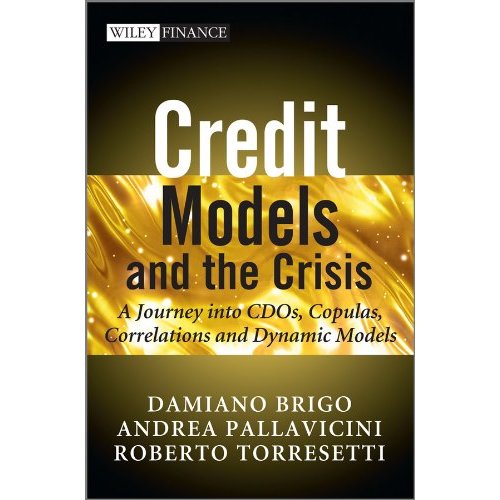back to Damiano
Brigo's professional page

Credit Models and the Crisis:
A journey into CDOs, Copulas,
Correlations and Dynamic Models
(Wiley Finance, April 2010)
by Damiano Brigo, Andrea Pallavicini and Roberto Torresetti
...Or: How I learned to Stop Worrying and Love the CDOs
The following information is available:
Book Description from the Back Cover
An extract from the book, featuring the preface, an earlier reduced version of a number of chapters, and the book table of contents.
Praise for the book, where short reviews or comments from colleagues are reported.
Places on the web where
the book can be ordered.
back to Damiano Brigo's professional page
Book Description from the Back Cover
The recent financial crisis has highlighted the need for better valuation models and risk management procedures, better understanding of structured products, and has called into question the actions of many financial institutions. It has become commonplace to blame the inadequacy of credit risk models, claiming that the crisis was due to sophisticated and obscure products being traded, but practitioners have for a long time been aware of the dangers and limitations of credit models. It would seem that a lack of understanding of these models is the root cause of their failures but until now little analysis had been published on the subject and, when published, it has gained very limited attention.
Credit Models and the Crisis is a succinct but technical analysis of the key aspects of the credit derivatives modeling problems, tracing the development (and flaws) of new quantitative methods for credit derivatives and CDOs up to and through the credit crisis. Responding to the immediate need for clarity in the market and academic research environments, this book follows the development of credit derivatives and CDOs at a technical level, analyzing the impact, strengths and weaknesses of methods ranging from the introduction of the Gaussian Copula model and the related implied correlations to the introduction of arbitrage-free dynamic loss models capable of calibrating all the tranches for all the maturities at the same time. It also illustrates the implied copula, a method that can consistently account for CDOs with different attachment and detachment points but not for different maturities, and explains why the Gaussian Copula model is still used in its base correlation formulation.
The book reports both alarming pre-crisis published research and market examples, as well as commentary through history, using data up to the end of 2009, making it an important addition to modern derivatives literature. With banks and regulators struggling to fully analyze at a technical level, many of the flaws in modern financial models, it will be indispensable for quantitative practitioners and academics who want to develop stable and functional models in the future.
Praise for the Book
Written by the well-known experts in the field, D. Brigo, A. Pallavicini and R. Torresetti, this little book is the most passionate and well-reasoned defense of the role of quantitative modeling in finance I have read so far. It would be helpful to anyone who wants to acquire an objective and unbiased view of the root causes of the current financial crisis. I recommend it highly.Alexander Lipton, Managing Director, Co-Head of the Global Quantitative Group, Bank of America Merrill Lynch; Visiting Professor, Imperial College
From a group of renowned experts in both theory and practice of credit risk comes this very timely volume, assessing in a masterful way the state of credit risk modeling vis-à-vis the financial markets in flux: pre-, in-, and, by extension, post- credit crunch crisis. Combined experience of the three authors provides for an in-depth critical analysis of what worked and what did not work in the credit risk modeling arena in the recent few years. The focus is on basket (correlation) models, as these proved to be the most challenging to build, and, in a sense, the most tricky to use. Anyone who attempts to build and/or to use pricing models for credit portfolios, should read the book.
The financial crisis highlights the need for a holistic, objective and transparent approach to the modeling of complex credit derivatives such as collateralized debt obligations. This interesting book describes the mechanics of popular contracts, exposes the major flaws of the market standard modeling approach, and discusses alternative modeling paradigms. I highly recommend it.
Kay Giesecke, Assistant Professor of Management Science and Engineering, Stanford University
Places on the web where the book can be ordered
Amazon UKAmazon USA
Amazon France
Amazon Germany
Amazon Japan
Amazon Canada
Wiley Europe
Wiley USA
Wiley ASIA
Barnes & Noble USA
WHSmith UK